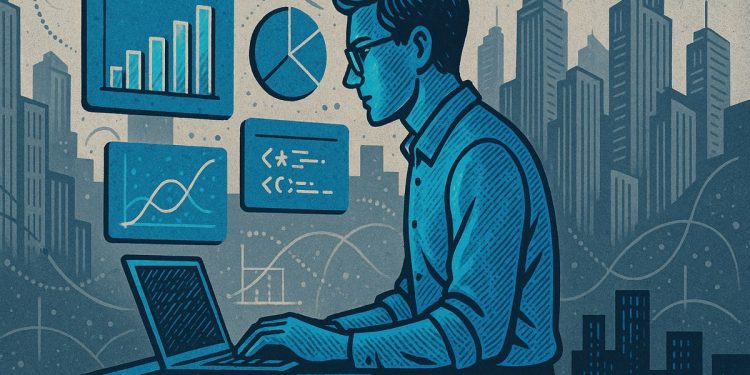By 2025, data analysts use AI tools to handle tedious tasks, letting them focus on quick discoveries and smart business advice. Their work is faster and more strategic, helping companies make better decisions in less time. Analysts who learn new skills, like special programming languages and business know-how, rise quickly in their careers. Instead of just making charts, they tell stories with data and help shape big company moves. In this new world, data analysts are more important than ever.
What does a data analyst do in 2025, and how has AI changed the role?
In 2025, data analysts are AI-augmented professionals focused on rapid, risk-aware decision support. AI automates data cleaning and visualization, freeing analysts to uncover business insights and ask strategic questions. Specialized skills, domain expertise, and data storytelling are now essential for career growth.
Mid-2025 marks a turning point for the data analyst role. While median pay crossed $90,000* * in the United States and demand is projected to grow well above average, the daily job looks radically different from just two years ago. AI is not eliminating analysts; it is off-loading the glue work** and pushing the discipline toward faster, risk-aware decision support.
The 2025 analyst at a glance
| Metric | Value | Source |
|---|---|---|
| Median US salary | $90,000 | 365 Data Science outlook 2025 |
| Time saved on data cleaning (avg) | 40-80 % | Coursera AI report 2025 |
| Share of tasks now AI-assisted | 60 % | Landing.Jobs survey, July 2025 |
What great analysts do differently
- Speed beats perfection.* Senior analysts now prototype insights in minutes by treating code as a disposable sketch pad. A “semi-sloppy” Python notebook that surfaces a new customer churn signal is worth more than a perfectly documented repo that arrives next quarter.
| Discipline | Core objective | Typical output |
|---|---|---|
| *Analytics * | Speed of discovery | Hypotheses, unknown unknowns |
| *Statistics * | Rigor of inference | Validated models, p-values |
| Machine Learning | Predictive power | Production-grade algorithms |
Great analysts stay in the first lane: they find questions nobody asked and hand them off to statisticians or ML engineers for formal testing.
How AI changes the workflow
- Data wrangling: Auto-cleaning tools such as AI-driven pandas extensions cut prep time by half.
- *Visualization: * Generative chart suggestions surface outliers faster than manual plotting.
- Code generation: Mojo and Julia snippets are auto-completed inside VS Code, letting analysts stay in “flow state” during exploration.
“The analyst who spends the afternoon hand-coding a heat map is already behind.”
– Industry survey, Landing.Jobs 2025
Career trajectory: from query to strategy
Traditional path: Analyst → Senior Analyst → Analytics Manager → Strategic Leadership.
2025 twist: domain specialization accelerates promotion. Healthcare analysts who understand HIPAA rules or fintech analysts fluent in Basel III capital requirements are fast-tracked into product and C-suite roles.
| Step | Skill added | Typical time to next level |
|---|---|---|
| Junior Analyst | SQL + Tableau + A/B tests | 18 months |
| Senior Analyst | AI tool stack, business context | 24 months |
| Analytics Manager | Governance, data storytelling | 36 months |
Emerging language toolkit
While Python and R still dominate job posts, niche languages are carving out utility roles.
| Language | 2024 TIOBE rank | 2025 use case |
|---|---|---|
| Mojo | #68 (was #194) | GPU-accelerated exploration |
| Julia | #28 | High-speed numerical kernels |
| Rust | #18 | Safe, concurrent ETL pipelines |
Analysts who add one of these languages to their stack are commanding a premium of 15-20 % in new offers Semaphore 2025 report.
Soft skills that still matter
- Hedging language: “It’s only a correlation, but I suspect…” prevents overconfident decisions.
- Multiple hypotheses: Presenting three competing interpretations keeps stakeholders from locking onto the first chart they see.
- Data storytelling: The final deliverable is no longer a dashboard; it is a three-slide narrative that frames risk, upside, and next experiment.
Skills roadmap for aspiring analysts
- Start here (0-6 months):*
- Python, SQL, Tableau
-
Complete an end-to-end A/B test with clean write-up
-
Level up (6-18 months):*
- Add AI-assisted workflows (auto-EDA, prompt-driven viz)
-
Specialize in one vertical (healthcare, fintech, e-commerce)
-
Go strategic (18-36 months):*
- Learn experimental design and causal inference
-
Master Mojo or Julia for speed-critical tasks
-
Resources:* Data Analyst Roadmap 2025 provides a step-by-step guide and resource links vetted by top employers.
The bottom line: the analyst who couples lightning-fast exploration with razor-sharp business judgment is becoming the internal thought leader every organization didn’t know it needed.
How has AI changed the daily workload of a data analyst in 2025?
The routine has flipped. AI automation now handles 40-80 % of the former grunt work – data cleaning, preprocessing, and even auto-generating initial visualizations – which used to eat up the bulk of an analyst’s day. Analysts report that instead of wrestling with spreadsheets, they now:
- Frame the right business questions before any data is touched
- Interpret and contextualize AI-flagged anomalies rather than hunting for them manually
- Story-tell results to non-technical stakeholders, converting dashboards into strategic narratives
Landing.Jobs summed it up: “Success now depends less on data handling and more on the quality of thinking applied to it.”
Which new programming languages should analysts learn beyond Python and R?
Python and R are still the bread and butter, but three newcomers are carving out niches:
- Mojo – Python-like syntax with C-level speed; ideal for GPU-accelerated analytic workloads
- Julia – Excellent for numerical-heavy, Matlab-style computations on large data sets
- Rust – Chosen for ultra-fast, safe, concurrent data pipelines when performance is non-negotiable
A 2025 TIOBE snapshot shows Mojo jumping from #194 to #68 in just twelve months, hinting at early-adoption momentum.
What is the typical 2025 salary range for data analysts in major tech hubs?
Global averages converge around $70k-$90k, with city-by-city variance:
| Tech Hub | 2025 Median (USD) |
|---|---|
| San Francisco | $120k+ |
| New York | $105k |
| London | $85k |
| Berlin | $80k |
| Bangalore | $70k |
Specializations (AI, experimentation design) or advanced degrees can push offers 20-30 % above these baselines.
How are analyst career paths evolving in 2025?
The classic ladder – Data Analyst → Senior Analyst → Analytics Manager – now branches earlier into strategic leadership roles. High-impact analysts who excel at surfacing unknown unknowns are fast-tracked into:
- Decision-making positions (product strategy, growth leadership)
- Hybrid AI-product roles (prompt engineer, data product manager)
A 2025 TechCanvass survey shows 27 % of senior analysts transitioned into cross-functional leadership within 18 months, compared to just 11 % in 2022.
What soft skills are separating top analysts from the pack?
Technical chops get you in the door; communication and ethics keep you in the room. Recruiters in 2025 rank the must-haves:
- Data storytelling – distilling complex findings into narratives executives remember
- Ethical oversight – spotting bias, ensuring GDPR/CCPA compliance, and explaining model limitations to stakeholders
- Cross-functional fluency – translating between marketing, finance, and engineering without jargon
In a University of Dallas poll, 61 % of hiring managers prioritized “explaining uncertainty” over pure modeling accuracy when deciding promotions.



















